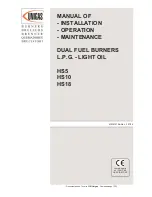
35
20138630
GB
Maintenance
7.1
Notes on safety for the maintenance
The periodic maintenance is essential for the good operation,
safety, yield and duration of the burner.
It allows you to reduce consumption and polluting emissions and
to keep the product in a reliable state over time.
Before carrying out any maintenance, cleaning or checking oper-
ations:
7.2
Maintenance programme
7.2.1
Maintenance frequency
7.2.2
Safety test - with gas feeding closed
For its safe commissioning it is very important to make sure that
the electrical wiring has been carried out correctly between the
gas valves and the burner.
To this end, after checking that the connections have been made
in conformity with the burner's wiring diagrams, a starting cycle
should be carried out with the gas tap closed (dry test).
1
The manual gas valve should be closed with the locking/re-
leasing device ("lock-out / tag out" procedure).
2
Make sure the limit electric contacts of the burner close
3
Make sure the contact of the minimum gas pressure switch
closes (where foreseen)
4
Proceed with a tentative start up of the burner.
The starting cycle should occur with the following phases:
–
Starting the fan motor for pre-purging
–
Carrying out the gas valve leak detection control, if applica-
ble.
–
Completing the pre-purging
–
Reaching the ignition point
–
Power supply of the ignition transformer
–
Power supply the gas valves.
Since the gas is closed, the burner will not be able to start and its
control box will stop or go into a safety lockout after the ignition
attempts set in the control box programming (usually 3 attempts).
The effective supplying of the gas valves can be checked with the
insertion of a tester; some valves are fitted with light signals (or
closure/opening position indicators) that are activated when the
electrical supply arrives.
7.2.3
Checking and cleaning
Combustion head
Open the burner and make sure that all components of the
combustion head are in good condition, not deformed by the
high temperatures, free of impurities from the surroundings
and correctly positioned.
Electrodes assembly
Make sure neither the electrodes nor probe show marked
warping or oxidation on surfaces. Make sure distances are still
being respected, readjusting to the right values where neces-
sary. Where necessary, remove oxide from the surface of the
probe with abrasive paper.
Burner
Check that there are not excess wear or loosen screws.
Clean the outside of the burner.
Clean and grease the adjustable profile of the cams.
Fan
Check the fan for dirt. A build-up of dust: a reduction in the air flow
rate and provoke polluting combustion.
7
Maintenance
DANGER
The maintenance interventions and the calibration
of the burner must only be carried out by qualified,
authorised personnel, in accordance with the con-
tents of this manual and in compliance with the
standards and regulations of current laws.
DANGER
Disconnect the electrical supply from the burner
by means of the main system switch.
DANGER
Turn off the fuel interception tap.
Wait for the components in contact with heat
sources to cool down completely.
The gas combustion system should be checked at
least once a year by a representative of the man-
ufacturer or another specialised technician.
WARNING
IF THE ELECTRICAL SUPPLY OF THE GAS
VALVES OCCURS AT AN UNEXPECTED MO-
MENT, DO NOT OPEN THE MANUAL VALVE,
DISCONNECT THE ELECTRICAL SUPPLY,
CHECK THE WIRING; CORRECT THE ER-
RORS AND CARRY OUT THE ENTIRE TEST
AGAIN.
The operator must use the required equipment
during maintenance.
















































